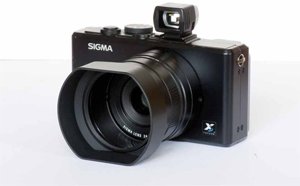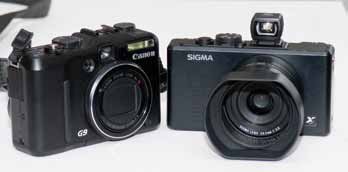articles/Cameras/sigmadp2-page1
Sigma DP2 Compact Camera - part 1 of 1 2 3 4
by Mike McNamee Published 01/12/2009

The Sigma DP2 is the successor of their DP1. It is characterised by great simplicity of design, it is essentially a 4 half x 2 half x 1quarter inch rectangular, black box with a lens on the front. What marks it out from other compacts is its full-size APS-C chip, the same size as that used for a great many D-SLR cameras. In addition it sports a Foveon chip and so, theoretically at least, there is less spatial interpolation for the detail (lightness) channel of the image. This is reflected in an image which has very high detail. The lens is a fixed 24.2mm focal length f2.8, equivalent to about 40mm in old money, 35mmm camera terms. There is no built-in viewfinder but one may be attached as an accessory to the flash bracket so as to provide a good, clear and bright view of the world you are about to photograph. There are, as with such devices, parallax considerations as soon as you start to work close in.
There is a built-in flash which is as dainty as the camera itself, but suffers from the same problems as others of its type, being too close to the lens axis and low in power - use for emergencies and at parties only! The otherwise excellent lens hood interferes with the light output of the flash, shielding all the near ground.
Overall then this is not a camera for most professional work but if you require a simple, lightweight recording tool with high resolution, and providing you can accept the fixed focal length, then it will cut the mustard. It is miniature only in size, not in performance. This quality comes at a price; the camera has a street price of around £600 and there are many alternatives up to that value.

On Test
We started by shooting a standard Macbeth ColorChecker 24 swatch card. This was made in open shade at 100ASA using auto exposure and auto white balance. As a test this was a mimic of pointing and shooting in JPEG mode and accepting whatever came out. The colour auditing algorithm actually threw an error, and told us to go back and shoot again at the correct exposure! The average error was almost 10 ΔE 2000, the image was 3 or 4 points too red in the neutrals, the white was visually ok. Overall the image was 9% too light.
The JPEG file was then opened into Adobe Camera RAW and corrected for both brightness and white balance, a trivially easy correction to make. This improved both the look and the accuracy of the target considerably, reducing the error to 5.4 ΔE 2000.
You are currently on page 1
- Sigma DP2 Compact Camera page 1
- Sigma DP2 Compact Camera page 2
- Sigma DP2 Compact Camera page 3
- Sigma DP2 Compact Camera page 4
1st Published 01/12/2009
last update 09/12/2022 14:58:55
More Cameras Articles
There are 0 days to get ready for The Society of Photographers Convention and Trade Show at The Novotel London West, Hammersmith ...
which starts on Wednesday 15th January 2025





